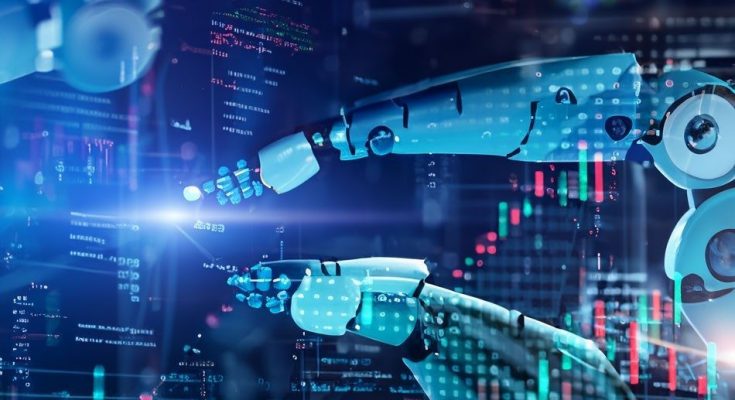The Future of Forex Trading: AI, Blockchain and Big Data
The foreign exchange (forex) market is the largest and most liquid in the world, moving trillions of dollars per day. Forex trading is the activity of buying and selling currencies from different countries, taking advantage of the fluctuations of exchange rates. Forex trading is a form of investment that requires knowledge, strategy and technology.
With the advances of technology, the use of artificial intelligence (AI), blockchain and big data will become more prevalent in the forex market. These technologies can bring benefits for traders, such as improving performance, reducing risks, increasing transparency, security and efficiency. In this article, we will explore how AI, blockchain and big data can transform the future of forex trading.
How AI and ML algorithms can improve trading performance and risk management
Artificial intelligence (AI) and machine learning (ML) are technologies that enable computers to analyze large amounts of data and make predictions based on historical patterns and trends. AI and ML can identify trading opportunities, execute orders and manage risks more efficiently than human traders.
AI and ML can help traders to:
- Analyze the market: AI and ML can process and interpret data from various sources, such as news, economic indicators, charts, social networks, etc. AI and ML can detect buy and sell signals, recognize patterns, trends and anomalies, and provide insights into the market behavior.
- Make decisions: AI and ML can use optimization, simulation and testing algorithms to evaluate different scenarios and trading strategies. AI and ML can suggest the best actions to take, taking into account the objectives, preferences and limits of the traders.
- Execute orders: AI and ML can automate the trading process, using robots or automated trading systems. These systems can monitor the market in real time, enter and exit positions, adjust the trading parameters, and avoid human errors, such as emotions, biases and delays.
- Manage risks: AI and ML can calculate and control the risks associated with forex trading, such as market risk, credit risk, liquidity risk, operational risk, etc. AI and ML can define and apply risk management rules, such as stop-loss, take-profit, trailing stop, etc. AI and ML can also alert traders about unexpected or adverse events that may affect the market.
How blockchain technology can enhance transparency, security and efficiency in the forex market
Blockchain is a technology that enables the creation of a distributed and immutable record of digital transactions. Blockchain works as a public ledger, where each transaction is validated and recorded by a network of computers, called nodes. Blockchain eliminates the need for intermediaries, such as banks, brokers, clearing houses, etc.
Blockchain can bring benefits for the forex market, such as:
- Increase transparency: Blockchain can make the forex market more transparent, as all transactions are recorded and visible to all participants. Blockchain can facilitate auditing, supervision and regulation of the market, avoiding fraud, manipulation and conflicts of interest.
- Increase security: Blockchain can make the forex market more secure, as transactions are encrypted, verified and immutable. Blockchain can prevent cyberattacks, theft, counterfeiting and data loss. Blockchain can also protect the identity and privacy of traders, using public and private keys.
- Increase efficiency: Blockchain can make the forex market more efficient, as transactions are performed in a direct, fast and cheap way. Blockchain can reduce operational costs, processing times, fees and commissions. Blockchain can also improve liquidity, accessibility and financial inclusion in the forex market.
How big data analytics can provide insights into market trends, patterns and opportunities
Big data analytics is the technology that enables the collection, storage, processing and analysis of large volumes of structured and unstructured data. Big data analytics can extract valuable and relevant information from data, using statistical, mathematical and computational techniques.
Big data analytics can help traders to:
- Understand the market: Big data analytics can provide a holistic and deep view of the forex market, using data from different sources, such as price history, trading volume, traders’ sentiments, geopolitical events, etc. Big data analytics can reveal the relationships, correlations and causes between the factors that influence the market.
- Predict the market: Big data analytics can provide a prospective and predictive view of the forex market, using models, algorithms and machine learning techniques. Big data analytics can estimate the probabilities, scenarios and outcomes of the market, based on historical and current data.
- Explore the market: Big data analytics can provide an exploratory and discovery view of the forex market, using tools, platforms and data visualizations. Big data analytics can identify and highlight the trends, patterns and trading opportunities in the market, based on the available data.
Conclusion
Forex trading is an activity that involves risks and rewards, and that depends on knowledge, strategy and technology. With the advances of technology, the use of AI, blockchain and big data will become more common and beneficial in the forex market. These technologies can improve performance, risk management, transparency, security and efficiency of traders. However, these technologies also bring challenges and limitations, such as reliability, ethics, regulation and competition. Therefore, traders should be prepared and updated for the future of forex trading in the age of AI, blockchain and big data.




